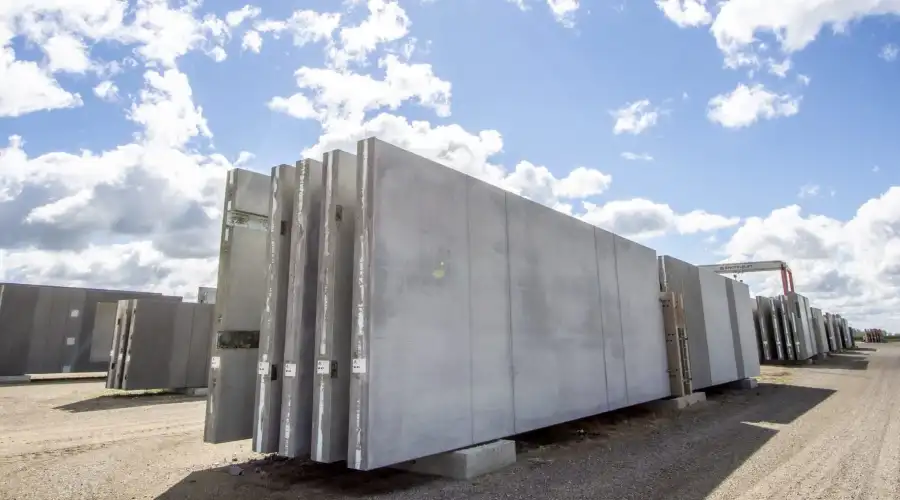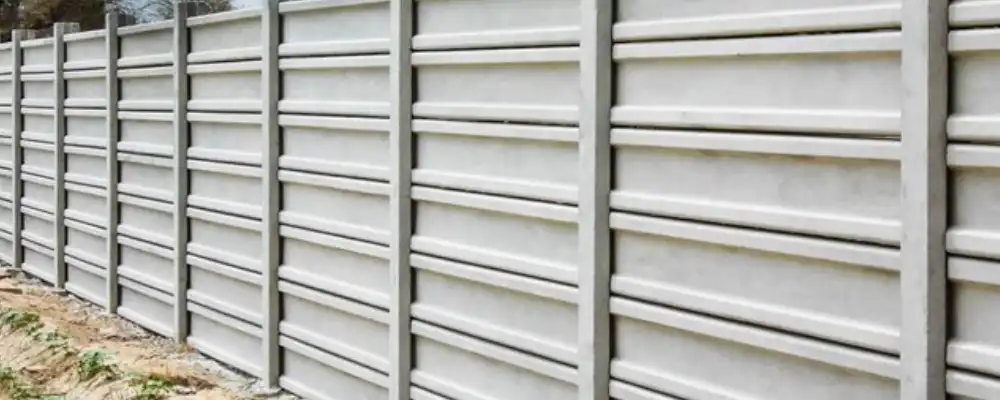Are you looking for an affordable, quick, and durable option for your property or project site? Are you a homeowner, builder, or business owner looking for a boundary option that is cost-effective, time-effective and durable, but doesn’t sacrifice quality? Then, a precast compound wall might be the solution to achieve your desired outcome!
We will provide you with a breakdown of all things precast compound walls, including the definition, types, advantages, applications, fabrication, and how they are adjusted to traditional walls. We will also provide you with information on how Brick & Bolt can assist you with the installation process with experts and reliable service.
What is a Precast Compound Wall?
A precast compound wall is short for an outdoor boundary wall that is made up of precast concrete panels that come from a controlled factory manufacturing site. Unlike traditional walls made of bricks or stones, which often rely on on-site labor with varying levels of quality assurance, precast walls offer a more consistent and reliable alternative.
These walls are produced using reusable concrete molds in controlled environments, ensuring uniform quality and reducing the need for frequent repairs. Once the panels are properly cured and meet safety standards, they are delivered to the site according to plan and are ready for immediate installation.
Types of Precast Compound Walls
Pre-cast concrete walls come in several types to meet various needs:
1. Plain Precast Wall Panels

These are the most basic and cost-effective types of walls. They are flat, smooth panels without any design, making them ideal for projects where functionality is the primary focus.
2. Textured or Patterned Precast Walls
These precast concrete wall panels are designed with aesthetic finishes such as brick textures, stone patterns, or custom motifs. They are often used in residential complexes, commercial buildings, or landscape projects to enhance visual appeal while maintaining the structural strength of concrete.
3. High-Security Precast Walls
Built using reinforced cement concrete with increased thickness and height, these walls are ideal for sensitive areas such as data centers, industrial plants, military zones, and factories. They may include features like barbed wire supports or anti-climb surfaces.
4. Readymade Boundary Walls
These are standardized, pre-engineered wall solutions manufactured in factories and delivered to the site ready for installation. They are commonly used for demarcating property boundaries in residential plots, institutional areas, and industrial zones.
Benefits of Precast Compound Walls
1. Save Time – Fast Installation
One of the most appealing advantages of precast walls is their rapid installation. Since the walls and posts are pre-manufactured, the installation can often be completed within a few hours, saving you weeks of construction time.
2. Quality
Being produced in a controlled environment ensures the quality is consistent, with proper curing and poured in a form that gives a measured uniformity for strength and finish in every panel.
3. Longevity Of Life And Long-Term Flexibility
Precast walls are built to survive the weather, the wear and the time. Precast walls are built to be altered in the future or added to without taking the entire wall down.
4. Strength and Structural
The walls are designed with steel bars for reinforcement and structural strength to make them suitable for many residential and industrial uses.
5. Fire Resistant / Sound Resistant
Precast walls are well-suited for high-risk or noisy environments due to concrete’s natural resistance to fire and sound.
6. Cost
Although precast walls seem to have higher upfront costs than traditional options, precast walls save money at the end of a project in labour and additional material costs, ongoing maintenance, and duration of the project.
7. Aesthetic Appeal
Precast walls are available in many designs, features, and textures, and with an opportunity for a number of finishes, precast walls have the ability and flexibility to be site-specific to the look and feel of the property, giving it a modern, contemporary touch.
Application of Precast Compound Walls
Precast compound walls are common for many sectors because they are long-lasting, easy to install, and require very little upkeep. Below is a description of how they are used in residential, commercial, and industrial settings:
- Residential Land and Villas
Precast walls are a popular option in the residential land market because they provide safety, privacy, and decorative appeal. The customizable designs and textures of the walls provide an attractive look to the home. The short installation time interferes less with the normal functioning of residential plots, especially where they are built in an already established residential location.
- Commercial Buildings

Most office buildings, malls, and commercial buildings use precast compound walls to protect the property and deter theft. The walls are the first line of defense for commercial properties in keeping out unauthorized entrants while also adding a professional element.
- Industrial Parks and Factories
Industrial parks and factories, from the perspective of occupational health and safety, are a prime location for requiring security and defensive measures. For industries that have collective raw materials or finished goods, whether it be outside activities or heavy machinery with vibrations or impact, a precast wall makes for a solid barrier against unauthorized entry and protects the site’s major investments in equipment, raw materials, and finished goods.
- Warehouses and Logistics Hubs
Logistics hubs and storage warehouses benefit from precast walls because they can be set up quickly over large areas. Precast walls keep the premises organized and safe while allowing smooth operation without long delays for boundary construction.
- Agricultural Lands
Precast compound walls are used by farmers and landowners to keep trespassers, thieves, and wildlife off their land. They can also be used to create a quiet, safe environment around their farmhouse or sheds. Being precast, these walls require comparatively very little effort to maintain – this is especially beneficial in remote/rural areas.
- Institutional Buildings (such as Schools and Colleges)
Schools, colleges, and educational institutions require strong boundary walls for safety.
Installation Process of a Precast Compound Wall
1. Site Preparation: In this step, the area will be cleared of debris and other objects like vegetation, among other things. Then, the area is levelled to provide a suitable area to install. Proper drainage needs to be dealt with too, at this stage, so as not to have any water-related issues down the road.
2. Mark Column Placement: The points along the line were marked in accordance with a level, and measurements should be taken to ensure that the precast column could be placed where indicated. Marking these points will help to keep consistent and spacing aligned and in line, whether it’s in succession of more than one installation, as an example regarding the structure itself or overall aesthetic or alignment with other portions of the structure for continuity or symmetry.
3. Excavate Column Pits: Holes were dug to the required depth at the marks made previously; this pit depth would match not only the size but also the anchoring, if required, per column. Your depth will vary depending on the soil as well as the wall height.
4. Place and Set Column: The precast concrete columns are then placed into the excavated holes. Using levels and string lines for vertical reference, concrete will fill the holes to set the columns. After placing the columns in the holes, it is cured for a certain period, depending on the work schedule and ensuring the required curing/setting is reached.
5. Installation of panels: Once the columns are installed, the precast wall panels are slid between the columns. Just remember, the wall panels are designed to slide into grooves or slots on the columns. The panels are stacked as needed for the desired wall height.
6. Alignment and finishing: Once all panels are installed, the whole wall will be checked for alignment, strength or integrity, and straightness or plumb. On occasion, two columns will not be aligned, so a small adjustment may be needed. A last application of plaster, paint or waterproof (weather) paint and/or coating is then applied for aesthetic and protective purposes.
Precast Compound Wall vs Traditional Compound Wall
| Feature | Precast Wall | Traditional Wall |
| Installation Time | Few hours | Weeks or months |
| Cost Efficiency | Cost-effective in the long run | High labor and material costs |
| Strength | High with steel reinforcement | Moderate to high, depending on the materials and construction quality |
| Aesthetics | Custom textures and designs are available | Requires external finishing |
| Maintenance | Low | Medium to high |
| Modifications | Easy to upgrade | Time-consuming |
| Environmental Impact | Minimal waste, reusable components | High waste, resource-intensive |
| Weather Resistance | Highly resistant to weather elements | Prone to cracks, erosion over time |
| Quality Control | Factory-made with consistent quality | On-site variation in materials and workmanship |
| Space Efficiency | Slim design saves space | Thicker structure occupies more area |
Limitations of Precast Compound Wall
- Design Restrictions: Existing variable finishes, there’s usually a limit to how complicated designs can be.
- Transportation: Large sizes in panels are difficult to handle, package and transport, especially in remote areas.
- Start-Up Expenses: Many molds require more upfront costs for the setup of the factory, but savings could be possible with long-term cost use.
- Post Installation: If the panels become damaged, we could be looking at more panel replacement than patch-in repairs.
Conclusion
Precast compound walls are a sleek and contemporary option to traditional boundary walls, giving speed, strength, savings, and style. Whether you’re securing a house, business, or large-scale infrastructure project, these walls give long-term protection without compromise. When you are ready to upgrade your property boundaries, contact Brick & Bolt for well-informed recommendations or a stress-free installation. By using precast, you can discover boundary wall construction in the new world today!

